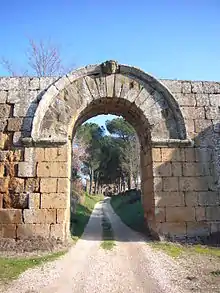Falerii Novi
Falerii Novi (English: New Falerii[1]) was a walled town in the Tiber River valley, about 50 kilometres (31 mi) north of Rome and 6 kilometres (3.7 mi) west of Civita Castellana.
 Entrance gate to Falerii Novi | |
 Shown within Italy | |
| Location | Falerii, Lazio, Italy |
|---|---|
| Coordinates | |
| Type | Settlement |
| History | |
| Founded | 241 B.C. |
| Abandoned | c. 700s A.D. |
| Cultures | Falisci Romans |
History
According to Polybius and Livy, the Falisci people of Falerii Veteres revolted against the Roman Republic in 241 B.C. Titus Manlius Torquatus was sent and during the first battle the Falerii defeated the Romans, but their cavalry was defeated. In the second battle the Romans defeated the Falerii. The slaves of the Falisci and half of their territory were seized, and Falerii Veteres was destroyed.[2][3] The war lasted six days, with the siege of Falerii Veteres taking three days.[4]
The Falisci were resettled in a new town in a less defensible position. It was built on the left bank of Rio Purgatorio on a slight volcanic plateau five kilometers west of Falerii Veteres. The walls of the city, made from tufa blocks, had fifty towers and nine gates.[5] The town remained inhabited until around 700 A.D.[6]
Excavations


In 1829, the theater was excavated and was discovered to have statues from the reign of Augustus depicting members of his family , with his wife Livia, and grandsons Gaius Caesar and Lucius Caesar. In 1903, the city plan of Falerii Novi was examined.[5]
In 2020, a ground-penetrating radar survey conducted by Cambridge and Ghent universities showed a network of water pipes that notably run under the blocks and not, as is more usual, along the streets. The survey also mapped a market, temple, bath complex and a public monument buried underneath the town[7][8]
Notable structures
The site contains the remnants of a Roman temple which is notable because it predates the settlement and because it is large, measuring roughly 120 metres (390 ft) long by 60 metres (200 ft) wide. The foundations of this temple were discovered by ground penetrating radar placing it several feet underneath the current excavations.[9]
An 11th Century Benedictine Abbey Church incorporating stone taken from the Roman structures is located near the west gate at Falerii Novi.[10]
References
- Valuing the Past in the Greco-Roman World. Brill. May 28, 2014. p. 99 – via Google Books.
- "Fragments of Book XII by Cassius Dio". Archived from the original on June 18, 2020.
- Downes, Sophy (2005). "Head of an Athlete from Falerii Novi". Papers of the British School at Rome. British School at Rome. 73: 271. doi:10.1017/S0068246200003044. JSTOR 40311098.
- Laurence, Ray (June 25, 2012). Roman Archaeology for Historians. Taylor & Francis – via Google Books.
- "FALERII NOVI (Santa Maria di Falleri) Italy". 1976. Archived from the original on June 18, 2020.
- "Archaeologists discover 'amazing' details of Roman city". June 9, 2020. Archived from the original on June 18, 2020.
- "Archaeologists Discover Details of Buried Roman City Without Digging". June 12, 2020. Archived from the original on June 18, 2020.
- "Archaeologists discovered 'elaborate' details of a complete ancient Roman city without digging". June 15, 2020. Archived from the original on June 18, 2020.
- Keating, Fiona (March 18, 2017). "Ancient Roman temple the size of St Paul's Cathedral discovered in Italy". ibtimes.co.uk. International Business Times. Retrieved March 20, 2017.
- Christie, Neil (2006). From Constantine to Charlemagne: An Archaeology of Italy AD 300–800. Routledge. ISBN 978-1859284216.